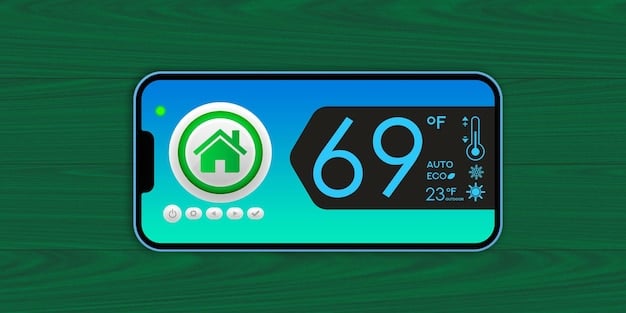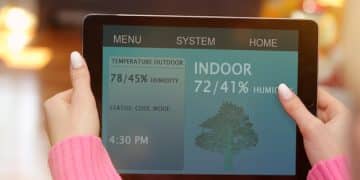Smart Thermostat Secrets: Cut Heating Costs by 15% This Winter

Discover
‘Smart Thermostat Secrets: Reduce Heating Costs by 15% This Winter’: by programming effectively, utilizing energy-saving modes, and optimizing placement, homeowners can achieve significant savings and improve home comfort.
As winter approaches, managing heating costs becomes crucial. With Smart Thermostat Secrets: Reduce Heating Costs by 15% This Winter, you can easily make your home not only warmer but also more energy-efficient.
Unlock Smart Thermostat Savings
Smart thermostats offer a fantastic way to control your home’s temperature and save money, but many users don’t utilize their full potential. Understanding the core features and leveraging them smartly can lead to significant energy savings.
Understanding Smart Thermostat Features
Dive into the myriad of features offered by modern smart thermostats and how they contribute to overall energy savings. The first step in maximizing savings is fully understanding the capabilities your smart thermostat offers.
- Geofencing: Automatically adjusts the temperature based on your location.
- Learning Mode: Learns your heating and cooling patterns over time.
- Scheduling: Pre-set temperatures for different times of the day.
- Remote Control: Adjust your thermostat from anywhere using your smartphone.
By familiarizing yourself with these basic functions, you can make informed decisions on how to configure your thermostat for optimal energy use.

Effectively using these features is essential for unlocking the energy-saving potential of your thermostat, making each setting work towards cutting down your heating bills.
Program Your Thermostat Like a Pro
Effective programming is crucial to maximizing savings. Don’t just set it and forget it; think strategically about when and how you heat your home.
Creating a Smart Schedule
A well-designed heating schedule considers your daily routines and habits. Set different temperatures for when you’re home, away, and asleep to avoid unnecessary heating.
- Weekday Settings: Lower the temperature during work hours.
- Weekend Settings: A slightly warmer setting for when you’re home.
- Night Settings: Reduce heating while you sleep.
- Vacation Mode: Significantly lower the temperature when you’re away for extended periods.
Tailoring your thermostat schedule for each day of the week improves energy efficiency, aligning with the household’s actual needs.
Fine-tuning your thermostat schedule is an ongoing process. Regularly reviewing and adjusting your settings keeps your energy use aligned with your lifestyle.
Optimize Thermostat Placement
The location of your thermostat can significantly impact its accuracy and efficiency. Ensure it’s placed in an area that provides a true representation of your home’s temperature.
Ideal Placement Tips
Choose a location that is free from drafts, direct sunlight, and other sources of heat or cold. An interior wall in a central living area is typically a good choice.
Avoid placing your thermostat:
- Near windows or doors.
- In direct sunlight
- Close to heat sources like lamps or fireplaces.
Consider replacing your current thermostat wiring during placement for best performance and long-term reliability, making sure to consult with an expert as needed.

Proper thermostat placement is a simple but effective way to ensure accurate temperature readings and efficient heating control. Optimizing placement, therefore, minimizes wasted energy.
Leverage Energy-Saving Modes
Most smart thermostats come with energy-saving modes that can help you reduce your heating costs. Explore and utilize options like “Eco” mode and “Away” mode.
Using Eco Mode
Eco mode is designed to balance comfort with energy savings. It typically lowers the temperature a few degrees to reduce energy consumption without sacrificing comfort.
Activating these functions offers a straightforward way to save on heating expenses, making it easier to keep bills manageable. Benefits include:
- Decreased energy consumption without too much impact on comfort.
- Automatic adjustments based on predefined energy-saving settings.
- Simple activation and deactivation as needed.
Energy-saving modes are easy to implement and can make a noticeable difference in your monthly bills, providing a practical way of minimizing energy use automatically.
Employing eco-friendly settings in your home is better for the environment. Combining this with the optimization of your thermostat schedule makes it easier to achieve energy efficiency and reduce the carbon footprint.
Integrate with Smart Home Systems
Connecting your smart thermostat with other smart home devices can further enhance its efficiency. Integrate with smart sensors to create a truly connected and efficient home.
Enhance Savings Through Integration
Automated actions can make your heating system smarter. Sensors can detect when rooms are unoccupied, automatically lowering the temperature in those areas.
Consider these integration possibilities:
- Smart Sensors: Adjust heating based on occupancy.
- Smart Blinds: Automatically open or close to regulate sunlight.
- Smart Outlets: Control space heaters and window AC units for zoned heating and cooling.
Further improve your energy efficiency by synchronizing each device, offering automated improvements tailored to unique environmental conditionals.
Linking all appropriate devices creates a synergy that maximizes energy savings, reducing waste. These integrated systems learn and adapt, offering a custom optimized experience.
Monitor and Adjust Regularly
Smart thermostats provide valuable data about your energy usage. Use this information to identify trends and make adjustments to optimize your savings.
Analyzing Energy Usage
Regularly review your smart thermostat’s energy usage reports. Look for patterns, trends, issues that might need to be addressed. Adjust your settings based on these insights.
Track these key metrics:
- Daily Energy Consumption: See how much you’re using each day.
- Peak Usage Times: Identify periods of highest energy consumption.
- Temperature Fluctuations: Monitor how your heating system maintains the desired temperature.
Optimizing these patterns makes it simpler to regulate the climate in the home while minimizing energy waste and helping to reduce environmental impact.
Feedback and improvements are critical parts of maintaining an effective system. Continuous adjustments will reflect the current need and improve performance further, saving you money and energy.
| Key Point | Brief Description |
|---|---|
| 💡 Program Settings | Create daily and weekly schedules. |
| 📍 Placement Matters | Position away from sunlight and drafts. |
| 🌿 Eco Mode | Use to reduce consumption modestly. |
| 🏠 Integration | Combine it with other smart functions. |
FAQ
▼
Geofencing uses your phone’s location to adjust the thermostat automatically when you leave or approach your home, preventing unnecessary heating or cooling when you’re away.
▼
Setting your thermostat to 55-60°F (13-16°C) when away is generally recommended. This prevents pipes from freezing and minimizes energy consumption.
▼
Reviewing your settings quarterly is advised to accommodate seasonal changes, adjustments to your routine, and optimize savings based on your energy consumption patterns.
▼
Yes, through energy savings, smart thermostats can pay for themselves over time. The timeframe varies depending on usage patterns, energy prices, and effectiveness in programming.
▼
While many homeowners install smart thermostats themselves, professional installation might be beneficial if you’re unfamiliar with electrical work or if your existing wiring is outdated.
Conclusion
Implementing these smart thermostat strategies can significantly reduce your heating costs, enhancing energy efficiency and overall home comfort. Take the reins on your energy consumption and save money this winter by programming effectively, optimizing placement, and leveraging energy-saving modes.





